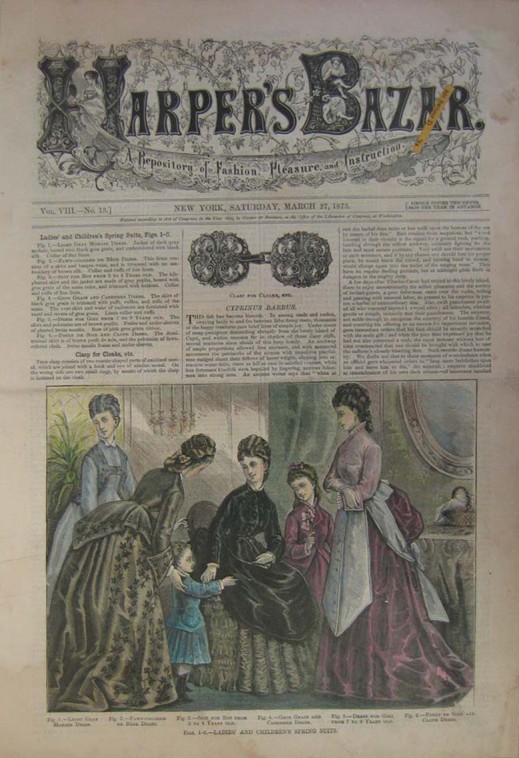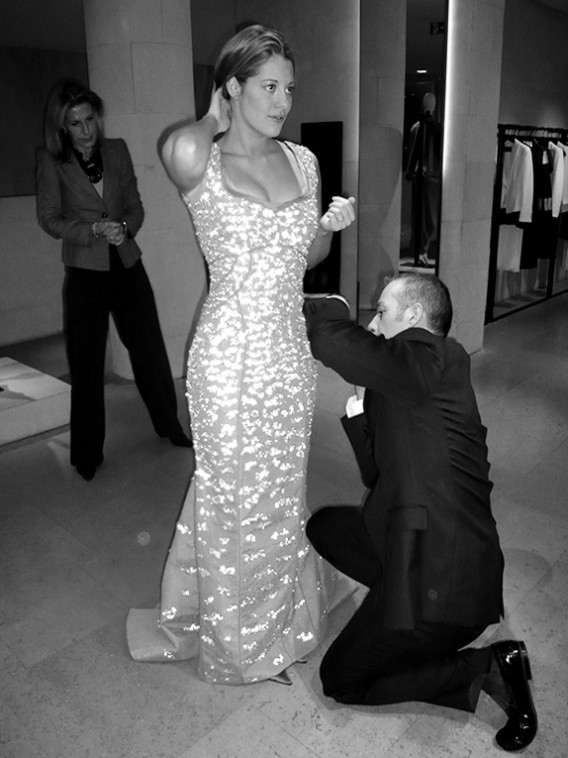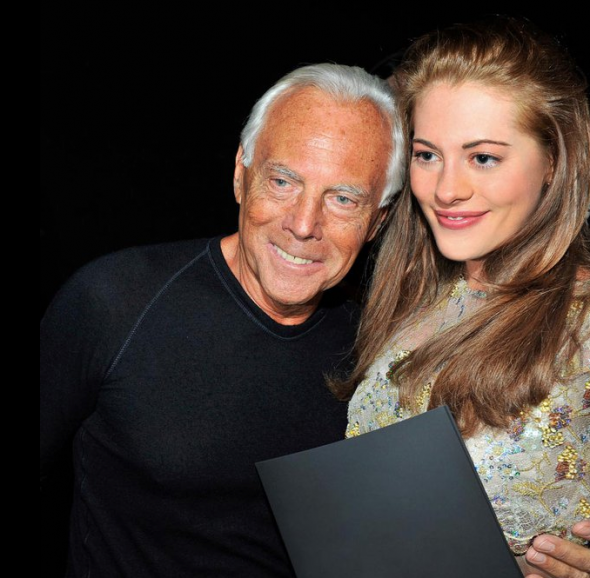While Haute Couture is highly celebrated on the red carpet, many fashion insiders seem confused over the true concept of the term.
Four years ago, I made a short, personal film that documented my journey as an Armani Privé client. At the time, a British newspaper commented, “(Haute Couture) is such an elitist thing and no one really understands the process you have to go through to get a dress. There are a lot of fittings and you have to stay the same size.” There certainly appears to be many misconceptions surrounding the definition of this crème de le crème of titles and it has been something of a mission for me to try to dissipate the mystery.
 In order to best understand, I like to refer to the designer pyramid, where haute couture is positioned above all else. While haute couture designs that are featured on the runway, may sometimes resemble artwork more than wearable fashions, they are in fact the inspiration for almost every piece of clothing you will ever purchase. When these collections are created, they set the standards for what will filter down to designers such as Prada, Dolce & Gabanna, Marc Jacobs and Diane Von Furstenberg, who then create prêt-a-porter (ready-to-wear) collections. Many designers have couture departments; an example would be Atelier Versace. An extension of Versace, the atelier (tailoring workshop) creates many of the long evening gowns and one-of-a-kind designs that are made to order to fit an individual’s body like a second skin. One step down from designers who have runway collections, are retailers such as Zara, Mango, Karen Millen, Reiss and Bebe. These stores have a higher turnover of clothing production and their designs are often copied from the ready–to-wear runway shows. Eventually, all of this is filtered down to companies such as Primark, Kmart and Wal-Mart, who mass-produce clothing that consumers can purchase for the fraction of the cost of the original design.
In order to best understand, I like to refer to the designer pyramid, where haute couture is positioned above all else. While haute couture designs that are featured on the runway, may sometimes resemble artwork more than wearable fashions, they are in fact the inspiration for almost every piece of clothing you will ever purchase. When these collections are created, they set the standards for what will filter down to designers such as Prada, Dolce & Gabanna, Marc Jacobs and Diane Von Furstenberg, who then create prêt-a-porter (ready-to-wear) collections. Many designers have couture departments; an example would be Atelier Versace. An extension of Versace, the atelier (tailoring workshop) creates many of the long evening gowns and one-of-a-kind designs that are made to order to fit an individual’s body like a second skin. One step down from designers who have runway collections, are retailers such as Zara, Mango, Karen Millen, Reiss and Bebe. These stores have a higher turnover of clothing production and their designs are often copied from the ready–to-wear runway shows. Eventually, all of this is filtered down to companies such as Primark, Kmart and Wal-Mart, who mass-produce clothing that consumers can purchase for the fraction of the cost of the original design.
The origin of couture dates back to mid-nineteenth century Paris, when Empress Eugénie elicited the dressmaking services of Charles Frederick Worth, an English designer who was known for his luxurious choice of fabrics, sumptuous trimmings and attention to detail. Her refined tastes set the style of the court and won Worth the title of Europe’s very first Couturier. Before long, Worth was patronized by many titled, rich and notable women. Being a savvy businessman, he took advantage of the growing demand for his work by opening a showroom, La Maison de Couture in Paris. Interested buyers would come to view his latest pieces on live models and order their garment of choice. Worth would then recreate the chosen garment in his atelier, modifying it to the client’s taste and precise measurements. This business model provided the foundation for modern day couture.
Worth has not only been credited for being the inventor of couture, but also for inventing the modern day press kit. Before the photographic era, he was the first to promote his work by sending out miniature dolls wearing his designs, which journalists then reproduced as illustrations, thus creating the original fashion editorials.
Haute couture, when translated, simply means high dressmaking, but is the most celebrated fashion honor. In France, the term is protected by law and defined by the Chambre de Commerce et d’Industrie de Paris. There are currently only eleven official members and three correspondent (foreign) members of the Chambre Syndicale de la Haute Couture, all of whom have been invited for membership and must follow certain rules in order to use the term in their advertising. Within this set of rules, each house is expected to operate a Paris-based atelier and show two full (thirty five pieces) collections, twice a year. These shows, which make up Paris Couture Week, are held during January and July and are not to be confused with the regular ‘fashion week’ which showcase the ready-to-wear collections.
Kirsten Lea at Armani Privé – Video Direction by Durrant Kellogg
Armani Privé, Valentino and Chanel are among the names currently boasting the most prestigious empires. Many see the stunning dresses featured on the red carpet, but are unsure as to how one would go about purchasing one. I recall seeing what would be my first haute couture gown, worn by Katie Holmes at her wedding reception. Even on the dimensionless page of a magazine, the dress spoke to me, implanting what would become a deep passion and lasting appetite for couture. It was only in my quest to purchase a gown of my own, did I learn that the ceremonious process by which one procures a couture dress proves as intricate, as the design itself.
Most designer stores, such as Giorgio Armani, are not closely connected to their couture house, and therefore it is mandatory for a new client to have a formal introduction to the atelier. This will usually require a new client to fly to Rome, Paris or Milan simply to view the look book. If one is interested in a particular gown, then that dress must also be flown in from wherever it is in the world, at that particular time.
Originally made for runway models, each sample garment is a prototype made specifically for runway models. This means they are made for women who are at least 5’10” tall, extremely slim, with almost no bust and a long back. The sample garments are later fashioned with elastic rigging, so to accommodate clients with more curves than zero.
It is at the atelier, where one discusses any modifications, to ensure that a dress will suit the client perfectly. The couturiers have great wisdom regarding which colors, necklines, hemlines and silhouettes enhance each individual body size and shape. And, when you’re buying a dress that costs in the region of $160,000, it doesn’t hurt to seek professional consultation. Ordering couture is about teamwork and creativity, a process in which the customer is a vital part.
Haute Couture garments often require three or four fittings. While it is helpful if the client remains the same size, the very nature of a fitting is to continually adjust the garment to fit one’s body like a second skin, so it is expected that women may lose or gain a little weight, particularly if they are leading up to an important event. By the end of the fittings, no matter how revealing a dress may appear to be, you will feel completely comfortable and secure wearing it.
Usually more so than any other dress you have ever worn.
With an estimated 2,000 people worldwide who still purchase haute couture, but as few as 150 individuals who are regarded as regular clientele, designers go to great lengths to build a sense of loyalty amongst their clients. Giorgio Armani, for example, hosted intimate dinners during which clients are brought together to share their passion for, knowledge of, and experiences with couture. The attendees are not the spoiled individuals some might expect. We share our thoughts on the latest collections and what we believe inspired them. We discuss plans to attend upcoming shows and most importantly, we rely upon each other to compare experiences of buying from one designer over another.
The 2011 Official List of Members of the Chambre Syndicale de la Haute Couture
Adeline André
Anne Valérie Hash
Atelier Gustavolins
Chanel
Christian Dior
Christophe Josse
Franck Sorbier
Givenchy
Jean-Paul Gautier
Maurizio Galante
Stéphane Rolland
Correspondent (Foreign) Members
Elie Saab
Giorgio Armani
Valentino
Maison Martin Margiela
Invited Members
Alexandre Vauthier
Alexis Mabille
Bouchra Jarrar
Julien Fournié
Lefrant Ferrant
Maison Rabih Kayrouz
Maxime Simoëns







